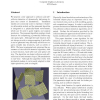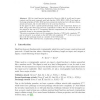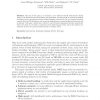VMV
2003
14 years 9 months ago
2003
We propose a new approach to collision and self– collision detection of dynamically deforming objects that consist of tetrahedrons. Tetrahedral meshes are commonly used to repre...
SECRYPT
2007
14 years 9 months ago
2007
Lately, hash function security has received increased attention. Especially after the recent attacks that were presented for SHA-1 and MD5, the need for a new and more robust hash...
SODA
2008
ACM
14 years 9 months ago
2008
ACM
Hashing is fundamental to many algorithms and data structures widely used in practice. For theoretical analysis of hashing, there have been two main approaches. First, one can ass...
ICISC
2007
14 years 9 months ago
2007
We present a collision attack on the hash function HAS-160 reduced to 53-steps. The attack has a complexity of about 235 hash computations. The attack is based on the work of Cho e...
FSE
2008
Springer
14 years 9 months ago
2008
Springer
MD4 is a hash function introduced by Rivest in 1990. It is still used in some contexts, and the most commonly used hash function (MD5, SHA-1, SHA-2) are based on the design princip...
FSE
2008
Springer
14 years 9 months ago
2008
Springer
The aim of this paper is to advocate a new software-oriented hash function family based on the HAIFA framework of Biham and Dunkelman, inheriting built-in randomized hashing and hi...
FSE
2008
Springer
14 years 9 months ago
2008
Springer
At Crypto 2007, Joux and Peyrin showed that the boomerang attack, a classical tool in block cipher cryptanalysis, can also be very useful when analyzing hash functions. They applie...
FSE
2008
Springer
14 years 9 months ago
2008
Springer
Hash functions are an important building block in almost all security applications. In the past few years, there have been major advances in the cryptanalysis of hash functions, es...
EUROCRYPT
2008
Springer
14 years 9 months ago
2008
Springer
Abstract. We develop a new generic long-message second preimage attack, based on combining the techniques in the second preimage attacks of Dean [8] and Kelsey and Schneier [16] wi...
CRYPTO
2008
Springer
14 years 9 months ago
2008
Springer
In this paper, we examine the resistance of the popular hash function SHA-1 and its predecessor SHA-0 against dedicated preimage attacks. In order to assess the security margin of ...






